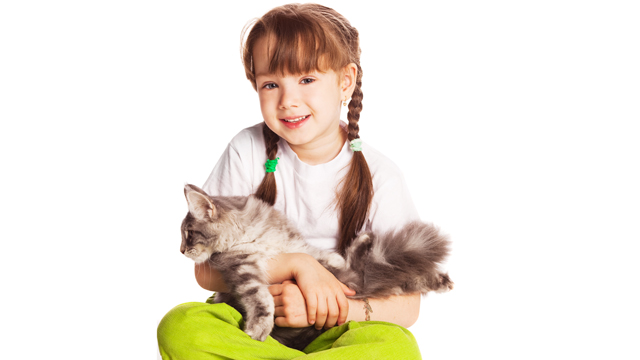Children love animals. This is just a simple fact of life. Place a puppy or kitten in front of any kid and you’re likely to hear squeals of excitement as they reach for that furry face. But interacting with children, especially young children, may not come naturally to all pets.
Kittens and cats can be especially challenging to assimilate into a household with toddlers to tweens. As a veterinarian who has lived with cats for over fourteen years, and a woman who has lived with young children (someone else’s) for the past six months, I have only recently begun to understand the new dynamic that children bring to cat ownership. Over the years, I have seen the unfortunate injuries to both cats and kids that can happen due to a lack of adult supervision or a lack of proper education. Nothing is more heartbreaking than for a family to have to say goodbye to a beloved cat because someone was injured. With a small amount of work on your part, you can ensure that both child and cat can have safe, comfortable interactions that will lead to a lifelong friendship.
Supervise all interactions and teach your child proper cat handling.
It is natural for children to be loud and grab for the nearest furry body part when they are excited. It is also natural for a cat to be fearful of loud noises, sudden movements, and surprise tail pulls. Put these together and you could have a recipe for disaster. Kittens may be less sensitive than mature cats to the noise and movement of children, but it is best to teach your child from the start what is best for the cat. Let them know that pulling tails and whiskers can hurt or scare a cat. Explain that most cats do not enjoy being picked up and carried around. And even if your cat allows this kind of handling, most cats do startle very easily and could unintentionally scratch what is closest to them at the time (a child’s face, for example). If your child insists on handling the cat and your cat is amenable to it, try to keep holding limited to time seated on the floor or on a couch or chair.
Watch your cat’s body language closely.
Growling or swatting are obvious signs of cat fear that most children can understand. More subtle signs that your cat is unhappy or uncertain about an interaction include tail swishing, pinned back ears, and a fluffed out or tucked under tail. With younger children, an adult should supervise all interactions; young children may miss the cat’s signals. With older children you can teach them the signs to look for that mean, quite simply, Fluffy has had enough! Once you and your children know what to look for, you can be sure to keep every interaction safe and fun for both child and cat.
Teach your cat to play with toys.
It may be natural for children to use their hands while trying to play with cats. Cats respond to movement and their antics can certainly make a child giggle and smile. But this kind of play can teach your cat that it is okay to use claws or even teeth on hands. Cats can play very roughly with other cats, but a child could potentially be injured or frightened by that kind of activity. From the start of the relationship, teach your child to use toys (feather wands, laser pointers, and the like) rather than their hands. With toys, the cat will never be confused about what is appropriate to bite, swat, or scratch.
Provide your cat with a place to go that is off-limits to your child.
Yes, I’m talking about a safe room for your cat. This is a very important, but often overlooked strategy to create harmony in a child-and-cat home. One of the most important things you can teach your child is that for a cat, their hiding spot is their sacred place. Don’t ever allow your child to pull or push your cat from a spot where they are clearly hiding or resting. When your cat is alert and interested in play, teach your child to use a favorite toy or treat to lure kitty out. If he comes out, that means he is ready to play; if not, that is cat speak for “I want some alone time.” Providing your cat with vertical space in the home in the form of shelves or cat trees is a good idea for general cat happiness. When there are young children in the household, these places are essential. If possible, provide your cat with a room that is off-limits to young children. This can be a bathroom or spare bedroom, or even a finished basement. Your cat should have undisturbed access to food, water, and a litterbox. Explain to your child that when a cat goes to his “room,” that means he needs a break. By their basic nature, cats do like to spend large amounts of time napping, alone, and undisturbed. If they are allowed this, they will be much more likely to enjoy and seek out playtime with you and your children.
Hopefully these simple strategies will help veteran and new cat owners assimilate these wonderful pets into their families without fear or mishaps. In my own experience, with proper education (for the kids) and resources (for the cat), happy cats and happy children can coexist!





